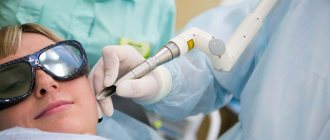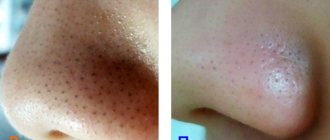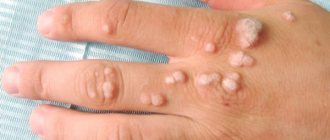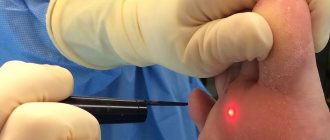REMOVAL OF NEW PLANTS
LASER KERATOMA REMOVAL
Duration of the procedure:
5-30 min.
Number of procedures:
1
Price:
from 200 rub. (depending on the category of complexity of the tumor + anesthesia)
Recovery period: 7-14 days
Equipment: CO2 laser
The number of people experiencing keratoma has increased significantly. Until now, it was generally accepted that this phenomenon is more typical for representatives of older generations who have crossed the 40-year mark. Due to age-related changes, various types of spots appear on their skin.
Today, doctors have come to a disappointing conclusion: keratoma is increasingly developing in young men and women, and moreover, in teenagers. The main cause of this problem is seen in excessive ultraviolet radiation.
Causes of keratomas
Keratoma is a benign skin growth that is flesh-colored or various shades of brown. Usually its shape is compared to a nodule, and when it grows to a plaque.
It is better to remove keratoma with a laser in the early stages. Otherwise, the surface layers of the epidermis grow, which is accompanied by peeling and, subsequently, excessive keratinization. Simply put, a crust forms, which can become cracked and even fall off, causing pain and even bleeding, so removal of keratomas must be carried out in a timely manner.
It is customary to distinguish different types of keratomas:
- senile;
- horny;
- follicular keratoma;
- seborrheic.
Keratoma occurs on the skin of men and women equally often. First of all, those areas of the body that are intensively exposed to the sun are at risk: the neck and face, hands, legs, back, etc.
Keratoma is often called the scary word “precancer.” Sooner or later, this skin tumor, increasing in breadth and depth, can become malignant. In other words, it will transform into squamous cell carcinoma.
How is the procedure done?
Laser removal of tumors in Moscow clinics is carried out in the following order:
- Preliminary consultation with examination of the skin and identification of potential contraindications. Determination of treatment tactics and preoperative preparation.
- Cleansing the area affected by the device and pain relief with an anesthetic - in the form of a cream or injection solution.
- Treatment of neoplasm.
If the doctor has suspicions about the future prognosis, he may take a sample of the removed material for testing in the laboratory. Then the patient receives a number of recommendations regarding the care of the area that has been subjected to laser destruction.
Timely treatment
The best way to fight cancer, one of the most terrible diseases facing humanity, is prevention. As soon as a keratoma appears, it is advisable to immediately, without delay, consult a dermatologist for laser removal. The smaller and more insignificant the skin tumor, the greater the likelihood that after its removal there will be no trace left on the body. Well, of course, such a step will significantly reduce the risk of malignant degeneration.
At the moment, only one way to treat keratoma is known - it must be removed.
This is a radical method, which can only be carried out efficiently by a qualified specialist. If suspicious growths are detected on the skin, you should contact specialized clinics and centers such as SkinLazerMed. The best option is to consult a dermatologist or dermato-oncologist.
Attempts to get rid of keratomas on your own can be fraught with the formation of unsightly scars at best, and the development of skin cancer at worst.
Removal using radio waves
Radioknife, or radio wave surgery (Surgitron device) is the most universal method for removing dermatological tumors, which can be used even in hard-to-reach locations. As in the previous case, the method is based on heating and evaporation of cells under the influence of radio frequency waves. The technology allows for targeted effects down to several millimeters. The surrounding tissues are not affected. Another advantage of the method is a good cosmetic result - healing occurs practically without the formation of noticeable marks and scars.
Keratoma removal methods
There are different ways to treat skin growths classified as keratoma:
- Removal of keratoma by using liquid nitrogen.
A widespread and affordable method that allows you to remove several keratomas in one session, however, it has a number of disadvantages: rough scars remain, a long recovery period, and complications are possible.
- Removal of keratoma by electrocoagulation.
By applying layer-by-layer current to the tissue around the keratoma and the vascular walls, it is possible to prevent bleeding and infection. The crusts disappear 7–10 days after the procedure. After removal of large defects, subtle, light-colored scars remain. Small keratomas disappear without a trace.
- Radio wave method.
Recognized as milder in impact, but no less traumatic.
- Laser removal of keratoma. One of the most effective modern techniques. Its essence lies in the painless “evaporation” of the tumor by exposure to high temperature. Thanks to the cooling system equipped with the laser equipment, the patient does not experience discomfort. It does not matter where the keratoma is located. Removal of keratoma using a laser is possible on any part of the body, including the hairline. The wound heals in just 1–2 weeks. There are practically no traces left. There are no age restrictions on the use of the laser method.
Benefits of tumor removal
An appointment with a doctor with extensive experience in the field of laser tumor removal will allow you to get rid of the defect without the risk of unpleasant complications. A visit to a specialist at EsteLab guarantees the following benefits:
- Speed of the procedure. As a rule, to remove a papilloma or wart, a few minutes are enough - from 5 to 20, depending on the size of the skin formation.
- Minimal trauma. The use of certified equipment and a professional approach allows you to get rid of the tumor without unnecessary damage to the skin.
- Short recovery period. The cover heals quickly (about 5-7 days), the patient does not have to “admire” a noticeable scar or scar at the site of a mole or keratoma.
It is important to consider: the only thing that may remain after the procedure is a small atrophic scar in the form of a light spot, which after complete healing is practically no different in color from the surrounding skin.
Contraindications to tumor removal
You should refuse to remove skin lesions with a laser if you have one or more contraindications:
- pregnancy and lactation;
- the presence of malignant tumors (especially in the uterus and ovaries);
- pathologies of the pelvic organs of an infectious-inflammatory nature;
- hematological diseases accompanied by blood clotting disorders;
- HPV with the formation of condylomas;
- diabetes mellitus in the stage of decompensation.
Even if the patient is not breastfeeding, the procedure should be avoided for 6 months after birth. Natural or artificial tanning is a relative contraindication - visiting a specialist to remove formations is allowed after the skin has acquired a natural color.
Keratoma removal Price
Keratoma, the removal of which by laser is relatively inexpensive, can be removed at different prices: the price range for laser keratoma removal is determined by the number of skin defects to be removed, their depth, complexity and other characteristics.
Our hair removal and cosmetology center “SkinLazerMed” specializes in a wide range of procedures that involve laser technology. We guarantee high-quality and painless keratoma removal on the same day of treatment.
How is the Laser Keratoma Removal procedure performed?
Removing a keratoma in this way is based on a laser beam affecting the affected area of the skin.
- Before starting the procedure, the dermatologist collects an anamnesis, finds out the characteristics of the patient’s health condition, possible contraindications to these manipulations, and tolerability of medications. These data allow you to determine the optimal power of the laser beam and the duration of its exposure, which allows you to perform the removal in one visit.
- A powerful cooling system is built into the equipment intended for exposure, this explains the comfort of laser keratoma removal. However, if the patient wishes, a subcutaneous injection of an anesthetic can be given to ensure that no discomfort occurs during the session.
- When it comes to a disease such as keratoma, laser removal is represented by stepwise “evaporation” of the affected tissue until the beam reaches a healthy layer of skin. During this procedure, bleeding occurs extremely rarely, but a small wound appears on the affected area. It is treated with antiseptic medications.
- The removed formation - keratoma, laser removal of which should be carried out only by a highly qualified specialist, should be monitored by a doctor for several more weeks.
The SkinLazerMed clinic will perform laser keratoma removal at an affordable price. The procedure is quick, effective and completely painless.
How to remove keratomas?
The CO2 laser currently has the greatest advantages for removing seborrheic keratosis:
- A very thin beam (200 µm) ensures precise manipulation;
- The presence of a super-pulse mode allows you to evaporate fabric without charring it. The doctor sees the tissue being treated, which allows precise control of the depth of treatment. Maximum radicalism is achieved without deep wounds “just in case.”
- The device does not come into contact with the surface of the skin. The impact is carried out only by a laser beam. Thus, greater asepsis is achieved.
- Removal of small formations is painless and does not require anesthesia. Large formations are additionally anesthetized.
- Minimal heating of the wound surface ensures hemostasis (the wound does not bleed) and creates favorable conditions for further healing (without the formation of a pronounced scar).
Laser keratoma removal - Before / After Photos
Post-procedure care
In order for the result of removing a mole, wart or any other formation to be predictable and recovery to be quick, you should adhere to the following rules:
- Do not wet the treatment area with water for 2-3 days until a thick crust appears.
- Do not be exposed to ultraviolet rays - artificial (solarium) and natural (sunlight) for 2-3 weeks after the procedure. Next, it is advisable to always protect the area with a cream with an SPF of at least 35.
- If the formation has been removed from the face, you should avoid foundations and powders for 3 weeks.
- Refusal to visit saunas, swimming pools and baths to minimize the risk of infection of the treated area for 1 month.
After the procedure itself, the specialist will tell you what antiseptic agents can be used to clean the skin area and how soon the crust should fall off (usually up to 7 days). After it has disappeared, you will need to apply restorative products to speed up the healing of the skin.
The use of adhesive plaster over the formed crust is contraindicated, as is the use of fat-based ointments or thick creams - the “greenhouse effect” will only slow down regeneration.
Where do keratomas most often form?
Keratomas can appear on any part of the body, as well as on the face. The tumor is a cosmetic defect. When squeezed by clothing and damaged, it becomes inflamed, bleeds, and provokes a secondary infection.
- Keratomas on the body Keratomas appear mainly on open areas of the body. They most often grow slowly, but can become injured and cause inflammation. Capillary keratoma on the leg or angiokeratoma is dark red or almost black in color. Outwardly, it resembles an irregularly shaped knot with unclear boundaries. Seborrheic keratomas on the arm are common, especially in patients over 50 years of age. The favorite location is the shoulders. In men, due to pronounced hair growth, keratomas appear on the hands more often. In this case, there is a dysfunction of the sebaceous glands with the formation of a large number of loose scales.
- Keratomas on the head Seborrheic keratomas form on the head. The disease begins with the appearance of yellow spots of small diameter. Gradually they become covered with scales, which grow and transform into crusts with cracks on the surface. Also, a follicular keratoma may appear on the head, resembling a flesh-colored nodule with a small depression in the center. Scales rarely appear on the surface of such a neoplasm. Magnetization of the tumor is unlikely.
- Keratomas on the face Solar and horny keratomas grow on the face. They are considered precancerous skin hyperplasias. Solar keratoma of the eye begins with the formation of small pink papules that are prone to peeling. After some time, they turn into brown plaques with a characteristic rim along the periphery. Solar keratoma on the eyelids and face is capable of spontaneous magnetization. Much less common on the face is keratoma keratoma or cutaneous horn. Outwardly, it resembles a convex tumor that rises above the surface of the skin
Contraindications for the procedure:
- treatment of cancer (receiving chemotherapy);
- pregnancy, breastfeeding period;
- colds and viral diseases (ARVI);
- diseases with skin manifestations (Herpes, Chickenpox, Rubella, etc.);
- temperature increase;
- diabetes mellitus (stage of decompensation);
- hypertensive crisis;
- skin autoimmune diseases (Lupus, Scleroderma, etc.) during exacerbation.
Preparation
It is important to undergo an examination by a dermatologist. First, the doctor will make an accurate diagnosis. Secondly, he will recommend a suitable removal method. Despite the versatility of the laser, some cases require the use of other methods. In addition, there are contraindications to any interventions, so it is important to consult a doctor and talk about your health status, and in many cases, undergo diagnostics. Otherwise, no specific preparation is required. It is best for women to schedule the intervention after menstruation, as sensitivity may increase during menstruation.
How dangerous is a keratoma?
For the most part, keratomas do not pose an oncological risk.
As mentioned above, keratoma keratoma and solar keratoma have an increased risk of malignancy. But what else is the danger of these skin formations? The fact is that even an experienced doctor is not always able to distinguish a keratoma from a malignant neoplasm using clinical methods.
Many malignant tumors at various stages of their development are similar to keratomas. Therefore, in all cases it is necessary to contact a dermatologist-oncologist; only a specialist can correctly diagnose and determine treatment tactics.
Also, keratomas can be dangerous due to complicated course. In the early stages of development, they cause only aesthetic inconvenience (which is important for women or when multiple keratomas are located in open areas of the body). But after the appearance and intensification of keratinization on the surface of the formations, additional complaints may occur - itching, pain, tingling in the area of the keratoma, with deep cracks and injury - the addition of an infection and the occurrence of inflammation, suppuration, with trauma and part of the crusts coming off the surface - severe bleeding.
To summarize: treatment of keratoma is necessary if malignant degeneration is suspected, with a complicated course, with rapid growth, as well as with aesthetic problems.









